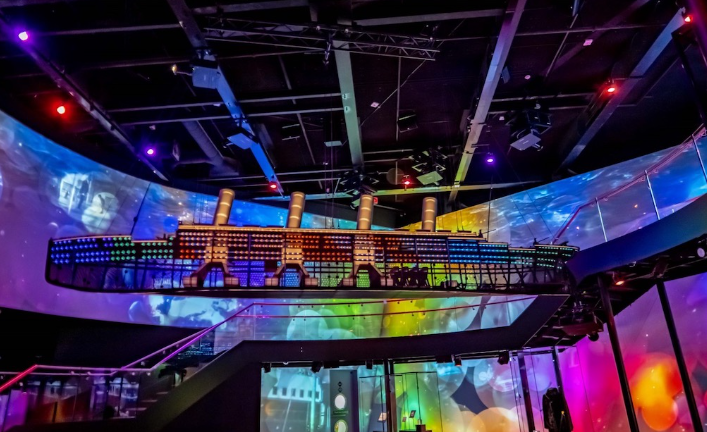Written by Daniela Karakaci, European Field Marketing Manager at Panasonic Connect Europe Visual Business Solution
In an era where digital media dominates entertainment and education, museums are experiencing a resurgence, captivating new audiences by transforming historical narratives into dynamic, immersive experiences.
Following a global downturn in museum attendance due to the pandemic, statistics from Statistica highlight a promising rebound, with museums like the Louvre witnessing a significant increase in visitors. London, often referred to as the museum capital of Europe, has seen a similar trend, with institutions like the Natural History Museum becoming one of the city’s most visited free attractions. This resurgence is partly attributed to the innovative approaches that museums are taking to attract new audiences, including immersive experiences.
At the forefront of this revolution are institutions like Titanic Belfast in Northern Ireland and the D-Day Museum in France, which, through innovative use of technology, are setting a new standard for how history is presented and experienced.
Bringing History to Life
Both museums have embraced immersive experiences to engage visitors in the stories of the past in ways previously unimaginable. By employing cutting-edge visual and auditory technologies, they offer visitors the opportunity to step back in time and experience history first-hand.
Titanic Belfast, with its interactive galleries, transports visitors to the early 1900s, offering insights into the ship’s design, construction, and the tragic story of its maiden voyage. The infamous RMS Titanic was a British passenger ocean liner that sank in the North Atlantic Ocean on April 15th, 1912, after striking an iceberg during her maiden voyage from Southampton to New York City.
Similarly, the D-Day Museum, at Arromanches-les-Bains on the Northern French coast, uses immersive displays to recount the monumental events of the 1944 Normandy landings in World War Two, allowing visitors to grasp the enormity of the operation and the bravery of those involved.
Enhancing Storytelling and Learning
The use of immersive experiences in museums and heritage sites has been shown to enhance storytelling, providing a more engaging narrative that challenges conventions and involves visitors more actively in the exploration of history. This approach not only makes the learning experience more enjoyable but also more impactful, fostering a deeper understanding and retention of historical facts.
Fostering Emotional Engagement and Social Experiences
Immersive experiences have the unique ability to evoke emotional responses and increase empathy among visitors, making the historical events they recount more relatable and impactful. By placing visitors in the midst of historical reconstructions, museums can create powerful social experiences, whether experienced in groups or alone. The shared experience of navigating through the immersive spaces of Titanic Belfast or the D-Day Museum promotes discussions, reflections, and a deeper emotional connection to the stories presented.
Authenticity and Embodied Interaction
In an age where authenticity is highly valued, immersive experiences also offer a sense of genuineness that traditional exhibits often cannot. Despite utilising digital technologies, these experiences remain grounded in physical reality, allowing visitors to use their senses fully as they explore. The immersive installations at Titanic Belfast and the D-Day Museum enable visitors to interact with history in a tangible way, changing their relationship with the space and the stories it holds.
The D-Day Museum, for example, depicts the invasion and subsequent construction of one of two artificial ports, named Mulberry Harbours. ‘Mulberry B’ was constructed at Arromanches to transport men, equipment, and supplies inland during the summer of 1944, circumnavigating the need to immediately capture the heavily fortified deep-water ports of Cherbourg and Le Havre. Logistics was key in the liberation of Europe and at its height, a full truck laden with supplies was leaving the artificial port every 80 seconds on average.
In one area, Panasonic projectors beam building images of the Mulberry B Harbour onto a transparent holographic canvas, situated in front of windows that overlook the English Channel. This enables visitors to witness the artificial harbour being constructed once again on the beach, just as it was in less than 10 days, in 1944.
Projector selection important
The careful selection of the projectors used in these museums is important to the success of the immersive experience. There are a number of areas to consider. The projectors must be able to deliver the highest quality colour visuals and brightness to suit the environment. This ensures the images seem as life-like as possible. The projectors must be positioned in the best place to not cast shadows and interrupt the immersive experience. The right choice of Ultra Short Throw lenses can assist in this area. The projectors must also be quiet, so as not to distract and, of course, reliable because they will be operating for long hours.
Conclusion
However, once the correct installation has been chosen, the successful integration of immersive experiences in museums represents a pivotal shift in how history is communicated to the public. By making historical events and narratives more accessible, engaging, and emotionally impactful, museums like Titanic Belfast and the D-Day Museum are not only attracting a new crowd but are also setting a new benchmark for educational and cultural institutions worldwide.
As this trend continues, we can anticipate a future where museum visits are universally recognised not just as educational outings, but as compelling, immersive journeys through time.
Discover more about the projection technology behind some of the greatest immersive experiences in the world and what might be best for your location.
